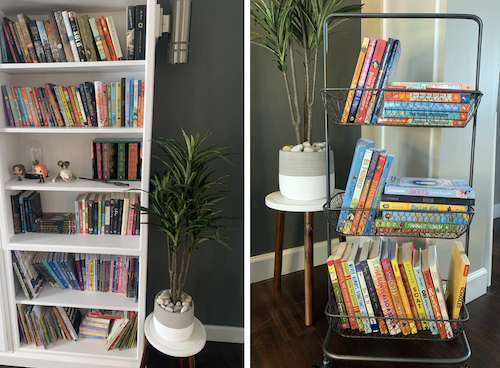

BLOGS > JANUARY 19, 2021
BY LAURALEE MOSS

Encouraging independent reading with middle and high school students is an important goal of English teachers.
The joy, the fun of a new book, of curling up to read and get lost in a story. All parts of a language arts class start with reading. As teachers implement whole class novels, literature circles and paired passages, they also encourage independent reading.
Why? Independent reading not only promotes a love of reading, but it also helps teachers meet standards. Language arts teachers share their love of literature with students, and they want students to experience the beauty that reading brings.
You probably need no convincing of the importance of independent reading with middle and high school students. Implementing a solid independent reading program does take intentional practices by the teacher.
Here are five practices to increase independent reading with middle and high school students.
Independent Reading Idea #1: Model Reading
Teachers model their own reading in a variety of ways. Some post a picture of the book outside their classroom, and others update letter boards with book titles. I typically keep my current book at the front of my rolling desk. At the end of each class period, I step into the hall with it and read a few pages between classes.
Additionally, if I find extra minutes during class, I read as well. Whenever I squeeze reading into my day, students ask me about my book or ask me what is happening in the book. Answering their questions allows me to explain fun parts of literature.
eLearning and independent reading strategy: Read at the start of class on video. Spend thirty seconds explaining to students what you like about your book or sharing an interesting quote. As you sign off with distance learning, show off your book again and encourage students to read.
Independent Reading Idea #2: Build Relationships
When you know your students, you will know their interests. To build relationships, I personally start slowly, often asking students about extracurricular activities or other classes. Sometimes I will notice a certain part of a student’s essay, and that leads me to understanding that student’s likes and dislikes.
Then, I can begin pulling books from my classroom library. I might show a student one or two books before class that I think will fit. If students reject those books, I ask for feedback and try again.
If you are using Follett Classroom Library Manager in your classroom, you can see the books students are checking out. This is particularly great for secondary teachers because with very large student numbers it’s challenging to see what they are each reading. This free tool lets teachers see what each student is reading in your classroom, so you have the chance to recommend other books and strike up conversations around what they are reading.
eLearning and independent reading strategy: Learning about students and their reading preferences online might not happen through daily interactions. Create a simple Google Form that asks about interests, reading preferences and hobbies. You can “shop” for student books and pair students with a few books for their choice.
Independent Reading Idea #3: Dedicate Time to Reading
Some students have opportunities to read at home. For others, we must show the importance of dedicating time to practicing independent reading. You can have students read at the start of class, almost as a bell ringer. Another option is to spend a portion of a dedicated day (say, every Friday) reading.
Finally, students can also read with extra time at the end of class. If students do not have lots of time, you can hand out a picture book or graphic novel to quickly engage students.
Check out #ClassroomBookADay on how to incorporate inclusive picture books with intention for secondary classrooms.
eLearning and independent reading strategy: Implement videos of authors reading the first chapter of their books. You can start with Follett’s #FirstChapterFriday videos where you’ll find authors reading the first chapter of their book.
Independent Reading Idea #4: “Try On” Different Books
I personally do not read every book I start because not every book appeals to me. Plus, I have experimented with enough genres to know I favor some more than others.
Be part of students’ developing tastes! Encourage their experimentations and show them how to “try on” different books until they find one they like.
A simple approach is to put a book on every desk. Ask students to take a few minutes to peruse the book and to trade with a neighbor if the book is not their preference. Add more books to the mix until students settle with a book they’ll enjoy.
eLearning and independent reading strategy: Use break-out groups to discuss different genres and potential books. Assign students to different groups to discuss similar books and take turns jumping into their breakout groups.
Independent Reading Idea #5: Connect Literature to Students’ Lives
Use the benefits of social media! Students have the opportunity to see authors on Twitter, Instagram, and Facebook. They can read interviews with authors and watch videos of authors. The more students see themselves in literature and the more they identify with writers, the more likely they are to pick up a new book.
Take screenshots of the author on Instagram, Twitter, or Facebook and share those with your students as an introduction to your First Chapter Friday reading. You can also check the author's website for "behind the scenes" images. Finally, you can find an interview with the author and play it or a clip.
Follett has many author interviews that you can share with students. You can find them all here.
eLearning and independent reading strategy: Ask students to share with you and their classmates popular writing hashtags, accounts and threads concerning literature. If students are not on social media, ask them to find an interesting article or interview with a modern author.
Purposefully implementing practices to increase independent reading with middle and high school students might feel forced at first. With a bit of preparation, language arts teachers can encourage independent reading with tweens and teens. Doing so will benefit classroom management, relationships with students, and overall student success – all lofty goals teachers can achieve.

LAURALEE MOSS
Lauralee Moss has taught high school English in Illinois for over ten years. She holds a BS in English Education from Southern Illinois University and an MA in Teaching and Leadership. She blogs at LanguageArtsClassroom.com.
You can find her on Instagram and at home with her husband, three kids, and crazy dog.
Crowdfunding in the Classroom: A Guide for K-12 Schools
June 20, 2024
We all want our children to have the best possible experience at school: in the classroom, on field trips, and in sports and after-school activities. However, K-12 school districts are facing a tight financial squeeze today. Budgets have been cut,...
Read more
10 Reasons to Love Follett Book eFairs
June 11, 2024
Students, librarians, teachers, parents, and community members love online book fundraising with Follett Book eFairs. Keep reading to learn the top 10 reasons why.Ready to save your dates? Click below and be among the first to know when fall 2024...
Read more
June 5, 2024
Our students and teachers are out for the summer and we are working on wrapping up things in our library. As I shared a few weeks ago, we are weeding, taking inventory and looking at our collection through analysis and...
Read more
June 5, 2024
At the end of each school year, I love sharing statistics from our library with our readers, teachers and school community. It is such a fun way to celebrate all of the reading and research our students did from the...
Read more
Revolutionizing Classroom Library Management in K-12 School Districts
May 23, 2024
IntroductionIn today’s educational landscape, ensuring that students have access to quality books in their classroom libraries is more crucial than ever. Classroom libraries play a vital role in fostering a love for reading, supporting literacy development, and catering to diverse...
Read more
May 22, 2024
School librarians are the unsung heroes of K-12 education, playing pivotal roles in enhancing students' learning experiences and supporting their colleagues. While their primary focus is often on maintaining and curating a diverse collection of resources, they also find themselves...
Read more